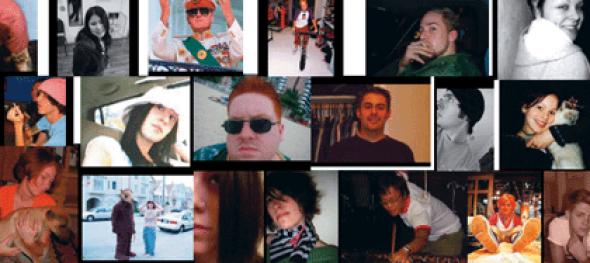Let's just be Friendsters
Ian Morrison investigates a new, networked generation of online dating services and discerns monkey-business as usual behind a satisfying user experience
Online dating agencies are nothing new. Take a look through your spam, and you’re sure to find invitations to ‘romantic’ services. You have an admirer, someone out there wants to be your friend. You don’t click on the link because you know it’s a lie. But naive victims are often rewarded with pornographic pictures; the last thing you want to see on a broken heart.
Other services rely on word of mouth recommendations, or spread the word with high profile TV campaigns. Everyone’s offering dating services these days. Is there room on the internet for yet another?
Faceparty.com is a typical example of an independent dating site. They have a database of around 1,100,000 people, all of which are searchable by sex, sexuality, age and location. Complete your search and you’re able to browse through the faces, but to make contact you must sign up for a free account. Pay the £20 annual membership fee, and you get to see who’s been looking at you, nudie photos of some of the saucier members, and access to some tools to make your profile look prettier. And it works too; just about. It’s slow and clunky, and the insane amount of banner ads don’t help, but the big problem is the sheer number of users in the database. A search for straight girls between 18-25 in London might return 3,000 hopefuls, but how can you tell which ones are lovely? Also, unlike Ebay, if the deal doesn’t work out it’s impossible to leave ‘negative feedback’.
Friendster.com is different, both in implementation and style. Its clean and minimal interface tessellates beautifully with its Java back-end. Despite being in the beta phase of development, and apparently under almost constant heavy load, it’s surprisingly responsive. Friendster seem to be taking their time to get it right, and that’s reflected in user loyalty.
The most interesting thing about Friendster is the way you join: you can go to Friendster.com and sign up, but you still won’t be able to see anybody else. You need to invite your friends. The idea behind all this is similar to the now defunct Sixdegrees.com: a database maps the relationship between its users to illustrate how they’re connected. Once you’ve started a network, and your friends invite their friends, you can contact anyone that’s part of your personal network. Because everyone has different friends, each personal network is unique. As the network grows and relates the connections, it develops exponentially.
At this point the service becomes a lot like Faceparty. Friendster pitches itself as a dating site, and so you have a powerful search feature to find people based on any part of their profile. The profiles are similar to LiveJournal.com, in that interests are automatically cross-referenced across the user base – go to your profile, click on ‘snowboarding’ and get a list of other web designers. It’s the fact that the interface and back-end work seamlessly together that makes Friendster fun. On your profile page you also have a list of friends complete with scaled down portraits. Clicking on a friend and browsing through their friends is, initially at least, quite an addictive pastime. As you go deeper into the network you see that you know friends of friends from other places, and it’s discovering these new social connections that make it so fascinating.
The success of Friendster is almost certainly the result of personal referral. The original testers were bloggers and technologists drawn in by the idea of exploring their social network electronically. They invited their friends, who in turn spread the word. The people that we knew and trusted never to spam us typed our address into an online form, and because of them we signed up. Infiltrating trust networks, Friendster is a more insidious and effective self-replicator than any TV-advertised dating line.
A few months later, Friendster’s weekly newsletter routinely announces that 3,000 new people are now part of our network. Unfortunately, we no longer bother to check who they are. Like most of these services, it seems that having gone to the trouble of making ourselves sound cool, completing our profile with facts and photos, few of us have the time or inclination to make it work for us...
Ian Morrison <ian AT darq.com> is a security analyst for Darq Ltd, an IT consultancy based in E1, London [http://darq.com ]
Mute Books Orders
For Mute Books distribution contact Anagram Books
contact@anagrambooks.com
For online purchases visit anagrambooks.com








